Some of the ads for allergy and asthma meds show pictures of goldenrod, falsely implicating it as the major culprit responsible for allergy symptoms at the end of summer. Perhaps that’s because the true culprits have barely visible, mostly green flowers that produce clouds of spiky pollen, that lead to the sneezing and wheezing of the season. Look to a couple of major Ambrosia species as the more likely source of your troubles.
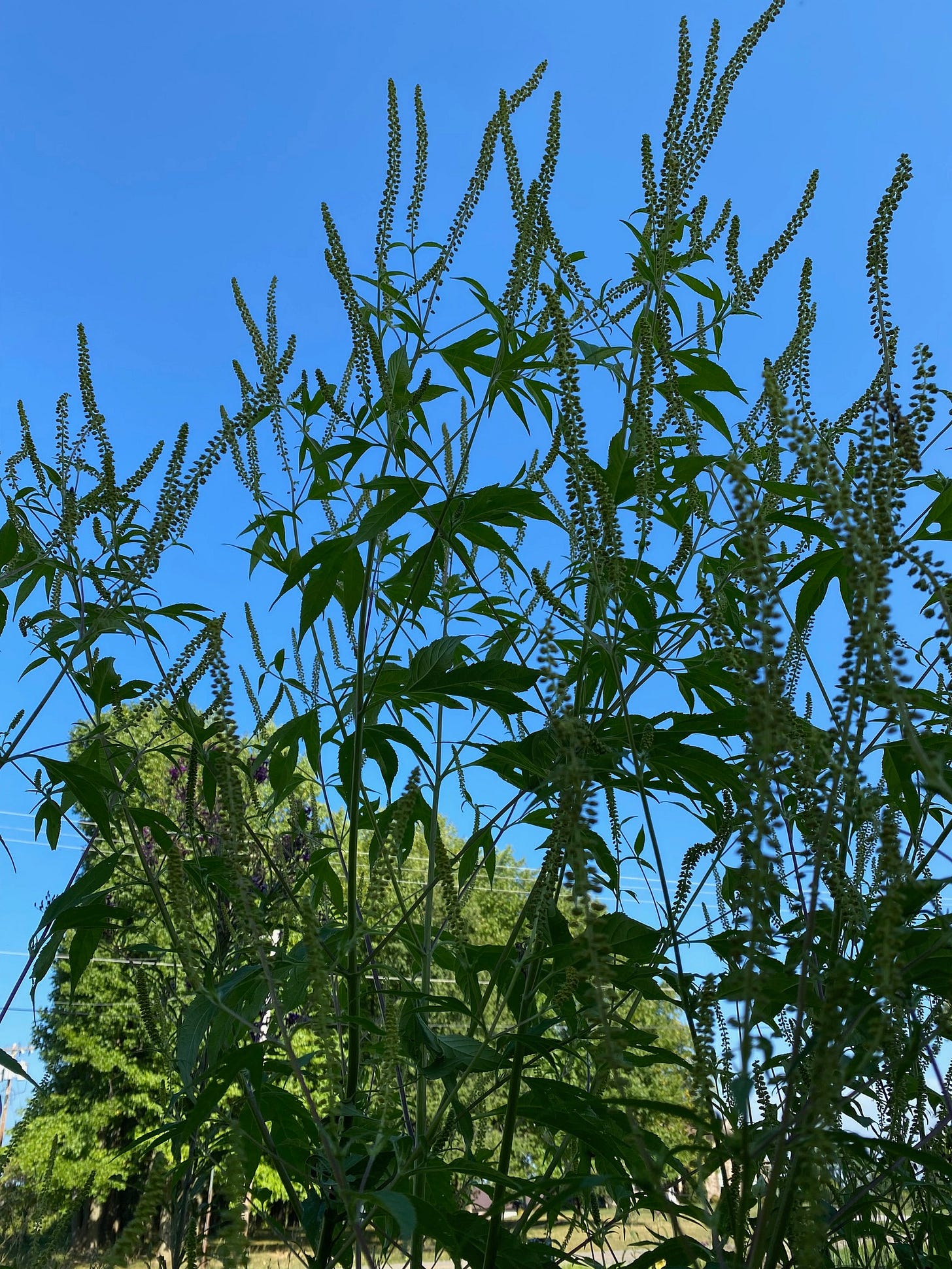
Goldenrod, which we’ll detail in an upcoming post, has large sticky pollen which doesn’t travel well on its own. Those granules rely much more on pollinators for dispersal, and are much less likely to be taken directly into your respiratory tract, unless one of our bumbles decides to seek nectar in your nostril. So you can count those allergy ads as an example of disinformation coming from big pharma. In our present time, one could become paranoid and wonder if the false representation was purposeful, so that people would chop down the wrong weed, and ignore their nemesis, thus prolonging their misery, and requiring more meds.
If the sun is just right, and there’s a breeze blowing, one can see actual clouds of pollen generated by the ragweeds. (The same goes for our pines and poplars at weedom, but is not the case for the very prolific goldenrod. )
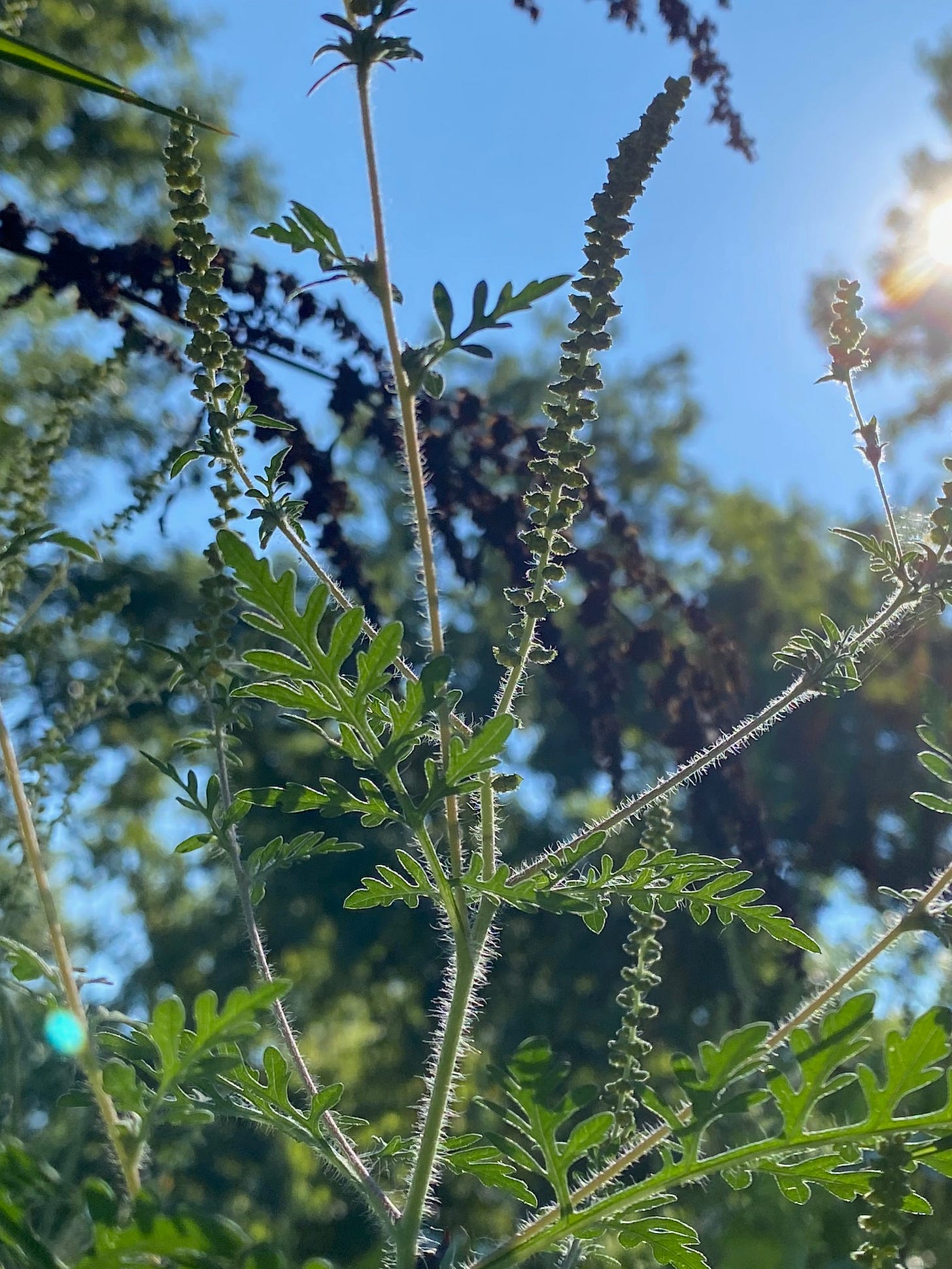
Turning to our botanical characters of interest, the smaller, common ragweed, Ambrosia artemisiifolia, and the giant ragweed, Ambrosia trifida belong to the family Asteraceae. After the next 3-5 minutes, you will know how to spot these two plants, and know the true bane of late summer allergy sufferers.
Flowers of common ragweed and giant ragweed are arranged in similar fashion, with male flowers occupying the upper portion of racemes, and less conspicuous female flowers occupying the armpits of leaves below. The main difference is in the length of the flowering raceme, which can be 20 or more cm. in the case of giant ragweed, and perhaps half that length, or less, in the case of common ragweed. The male flowers, with sepals above, appear mostly green, and yellow petals of multiple male flowers show on the underside of the sepals as they open. Hairy green floral structures of the female flowers face upward to catch pollen from the male flowers above. (This arrangement is somewhat reminiscent of the way that corn accomplishes the job of reproduction, male tassels above, and female flowers below.) Later in the season, the male flowers fall off, leaving a bare stem, which itself falls off as the female flowers mature into fruits and seeds. Good closeup pictures of the floral structures can be seen at Angelyn’s, Identify That Plant, and at North Carolina State extension.
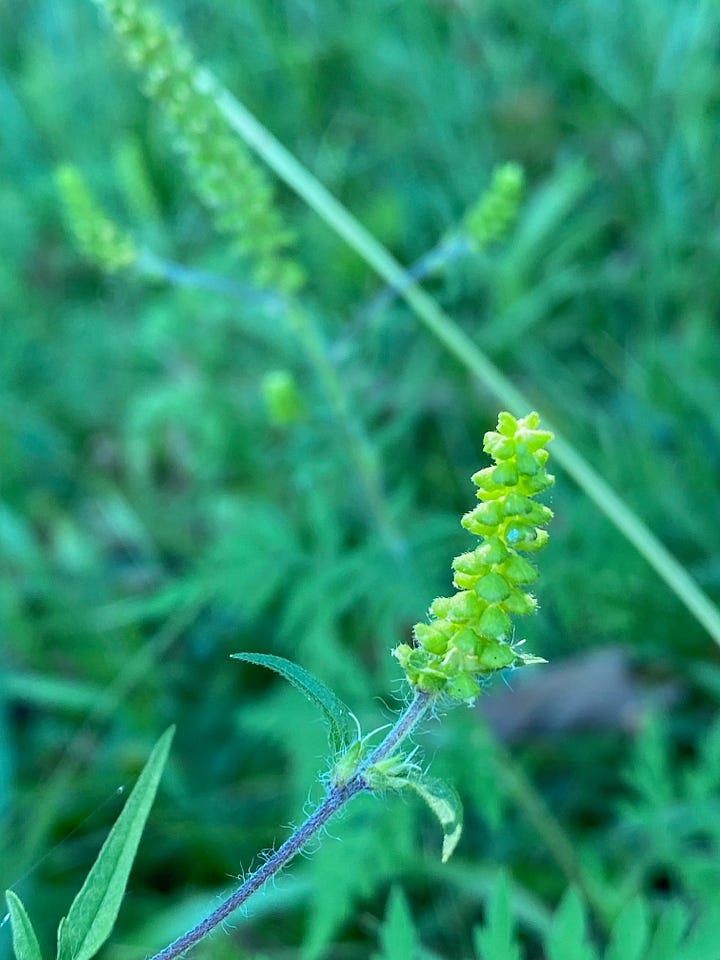
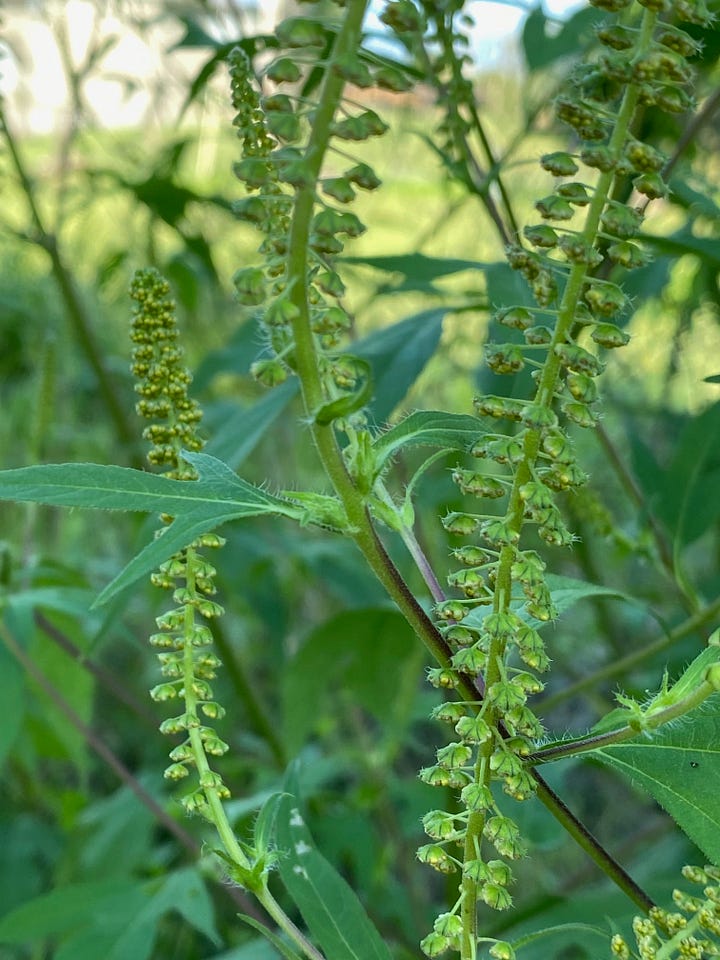
The deeply lobed leaves of common ragweed, can cause young plants be confused with some other weeds, such as Spanish needles, or even poison hemlock, but remembering that these ragweed leaves are not so sharply cut, and that they are not at all shiny, will help you to distinguish them early. Also the doubly pinnate leaves of common ragweed have a rough feel from tiny hairs on the midribs, margins and scattered elsewhere. Margins of the leaves are entire, and the tips of lobes are rounded.
Leaves of giant ragweed are likewise rough with short hairs, but they may have somewhat coarsely toothed margins, and are of variable shape. The large, palmately veined, lower leaves usually have 3 distinct, large lobes, but may have 5. Upper leaves may have 3 lobes or may simply be oval. By late summer the leaves are well chewed by caterpillars. Some larger hairs occur on the leaf petioles and base of the flowering racemes.
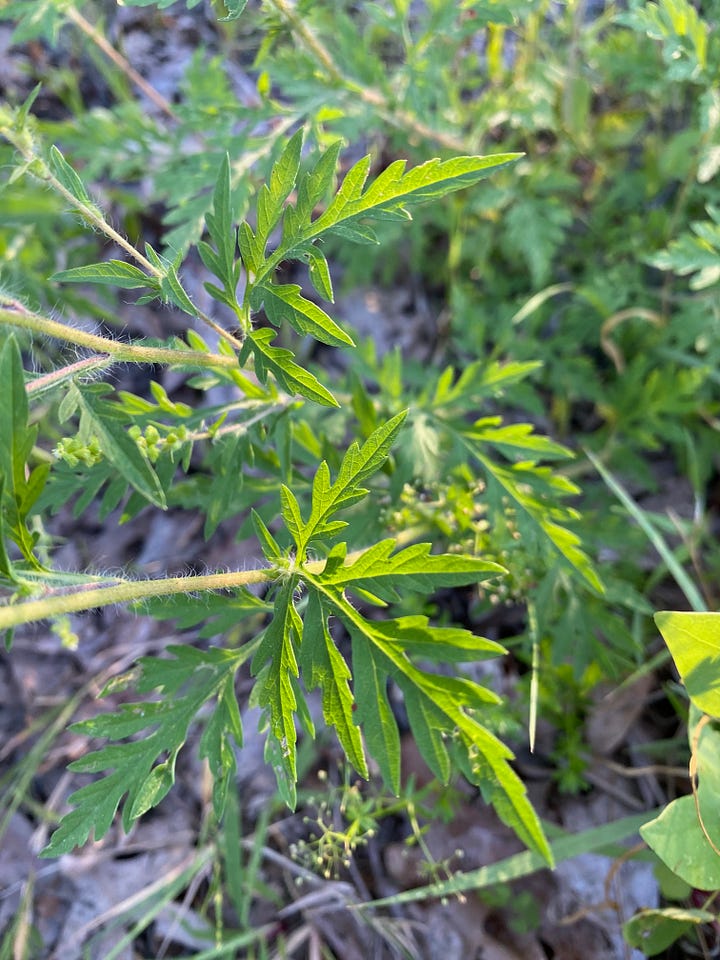
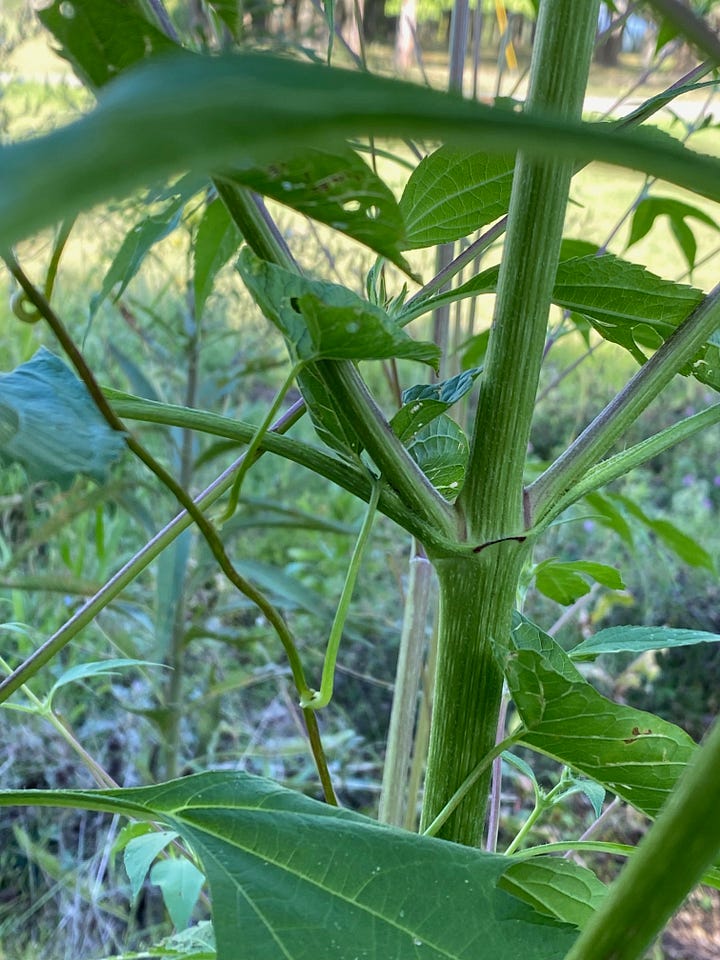
Stems of the ragweeds are notably different in size, and degree of hairiness. Giant ragweed becomes a bit tree-like as it matures, with the mostly smooth, and ribbed stem becoming well more than an inch in diameter. Hairs of the giant ragweed are confined mostly to leaf petioles and the flowering structures. Copious long hairs occupy all parts of the stems and petioles of the smaller, common ragweed.

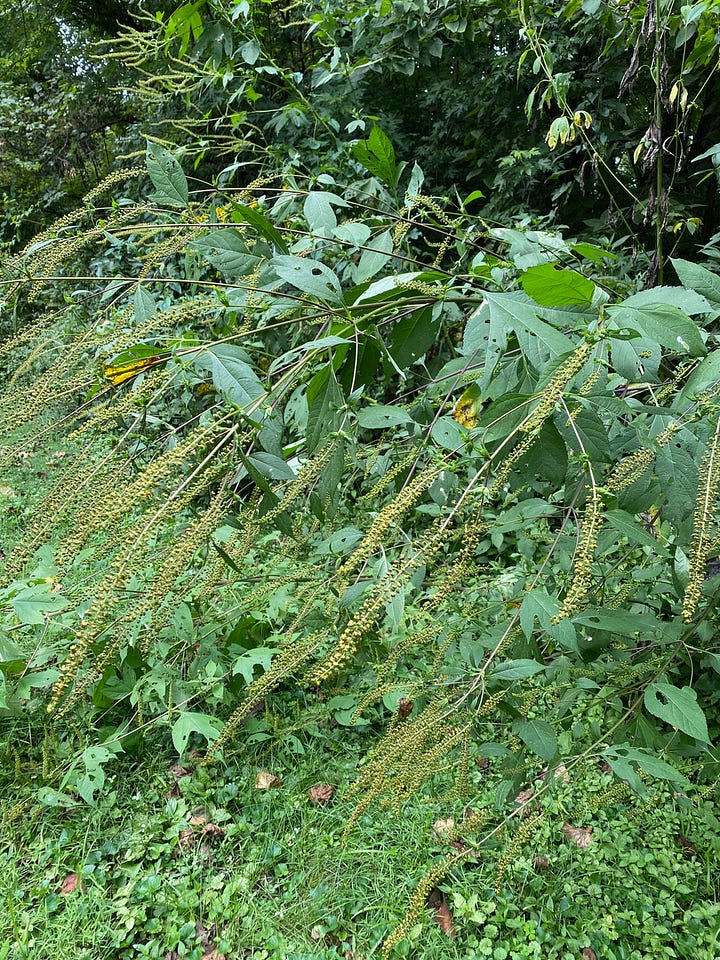
Given the reputation of ragweeds for causing respiratory mayhem among the allergic, we could wonder how they gained the name Ambrosia, “food of the gods”. There’s medicine in those plants, as is the case for so many others. They exhibit some ability to stabilize mast cells, which inhibits histamine release. As we find in almost every weed, anti-inflammatory substances are present. Therefore these weeds may alleviate the problems that they cause. Prior to flowering, it’s possible to obtain the benefits directly from eating or using the leaves. Certain herbalists point out that allergic people will not want to use pollen drenched leaves. This point of view is favored at weedom.
Other herbalists prefer tincturing the fresh plant material, including flowering tops and leaves. Perhaps they have homeopathic mechanisms in mind. If ragweed makes you sneeze, perhaps hand off some vodka, a jar and some scissors to an unaffected friend to get this job done. Those with asthmatic reactions, hives, or history of anaphylactic reactions to ragweeds or plants from the Asteraceae family should not try this at home.
Another caveat is to avoid confusion among the old herbals, which use the ‘ragweed’ or ‘ragwort’ term to refer to an old remedy of Senecio species, which was used for female specific disorders, and has some toxic liabilities.
More uses of plants from the ragweed genus include topical vulnerary use as styptic herbs to stop surface bleeding, as treatment for hemorrhoids, for intestinal parasites, to treat diarrhea, as an emetic, and to address female specific issues. Analysis of some 60 plus components in the essential oils of Ambrosia species shows the presence of some favorite substances with known anti-microbial activity. Seeds of these species, found in ancient human commodes of North America reveal that there was some reason for ancient natives to be eating them. Though their content of useful oils is considerable, the tiny size and large effort left people to conjecture that medicine was being sought, rather than food value.
The ability of Ambrosia species to inhibit their own germination, as well as competition from other species, has been leading much of the agricultural study of these species. They also appear useful for the uptake of lead from the soil, so that they have value as soil remediators to remove heavy metals.
We’ll move onto some other weeds, with less allergenic potential, for their antihistaminic, antimicrobial and healing benefits, but will keep our ragweeds in mind, should they succeed in taking over the earth.
There will be a photo showing a goldenrod top in SubStack Chat, and we will get a blooming picture in there as soon as one shows up. Also we’ll show you the pic of CVS getting it wrong about their generic antihistamine’s reason for being. Feel free to share some of your own pics, questions or answers. The threads are open to all.
Where We Dig
1. Hutchens AR. Indian Herbalogy of North America. Shambhala; Distributed in the United States by Random House; 1991. https://openlibrary.org/books/OL1567124M/Indian_herbalogy_of_North_America
2. Iamonico D. Ambrosia artemisiifolia (common ragweed). CABI Compendium. 2016;CABI Compendium:4691. doi:10.1079/cabicompendium.4691
3. Iamonico D. Ambrosia trifida (giant ragweed). CABI Compendium. 2016;CABI Compendium:4693. doi:10.1079/cabicompendium.4693
4. Tierra M. Like Treats Like: Ragweed to Treat Allergies. East West School of Planetary Herbology. Published March 18, 2013. Accessed August 28, 2023. https://planetherbs.com/blogs/michaels-blogs/like-treats-like-ragweed-to-treat-allergies/
5. Wood M. The Earthwise Herbal. North Atlantic Books; 2009. https://openlibrary.org/books/OL22552057M/The_earthwise_herbal.
6. Xu K, Liu X, Zhao C, et al. Nitrogen deposition further increases Ambrosia trifida root exudate invasiveness under global warming. Environ Monit Assess. 2023;195(6):759. doi:10.1007/s10661-023-11380-w
7. Ambrosia artemisiifolia (American Wormwood, Bitterweed, Blackweed, Carrot Weed, Common Ragweed, Hay Fever Weed, Ragweed) | North Carolina Extension Gardener Plant Toolbox. Accessed August 29, 2023. https://plants.ces.ncsu.edu/plants/ambrosia-artemisiifolia/
8. Ambrosia trifida Giant Ragweed, Great ragweed, Texan great ragweed, Bitterweed, Bloodweed, Buffalo Weed, Horse Cane PFAF Plant Database. Accessed August 29, 2023. https://pfaf.org/User/Plant.aspx?LatinName=Ambrosia+trifida
9. Ambrosin, a potent NF-κβ inhibitor, ameliorates lipopolysaccharide induced memory impairment, comparison to curcumin | PLOS ONE. Accessed August 29, 2023. https://journals.plos.org/plosone/article?id=10.1371/journal.pone.0219378
10. Clinical Plant Tidbits - Pacific School of Herbal Medicine. Accessed August 28, 2023. http://pshm.org/clinical_tidbits.shtml
11. CVS Health Allergy Relief Diphenhydramine Tablets (FSA Eligible) - CVS Pharmacy. Accessed August 28, 2023. https://www.cvs.com/shop/cvs-health-allergy-relief-diphenhydramine-tablets-prodid-1011700
12. Ragweed | Identify that Plant. Accessed August 28, 2023. https://identifythatplant.com/ragweed/
13. Experimental Ragweed Therapy Offers Allergy Sufferers Longer Relief with Fewer Shots. National Institutes of Health (NIH). Published January 7, 2016. Accessed August 28, 2023. https://www.nih.gov/news-events/news-releases/experimental-ragweed-therapy-offers-allergy-sufferers-longer-relief-fewer-shots
14. Goldenrod Love. Acorn Herbals. Published January 31, 2018. Accessed August 28, 2023. http://www.acornherbals.com/herb-information/2018/1/31/goldenrod-love
15. Ragweed – Ambrosia Artemisiifolia: Edible & Medicinal Uses of the Sneeziest of Wild Plants - Song of the Woods. Published July 23, 2021. Accessed August 29, 2023. https://www.songofthewoods.com/ragweed-ambrosia-artemisiifolia/





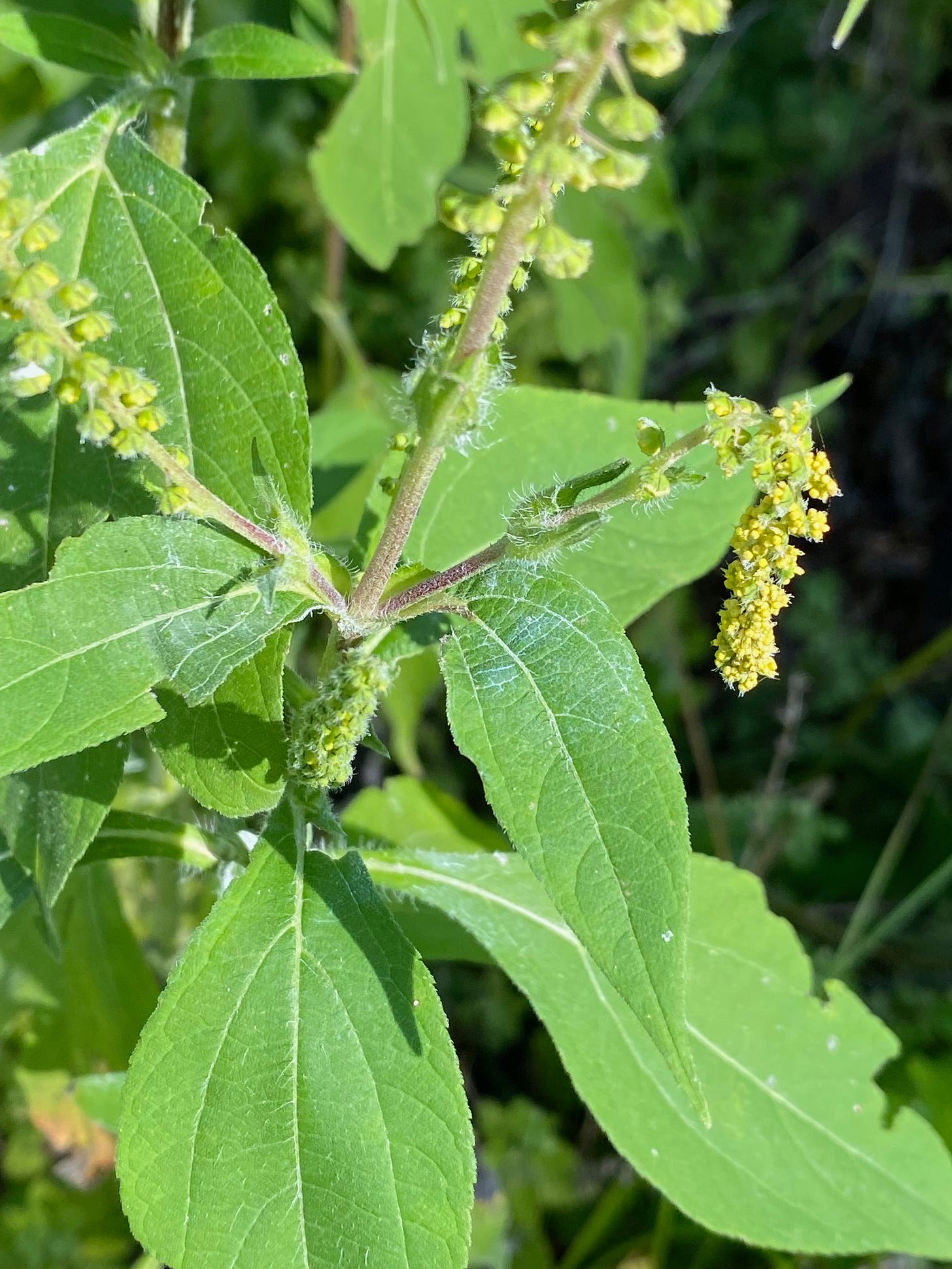

I include ragweed leaf in my daily bitters formula for allergies - good stuff and actually a pretty little plant.